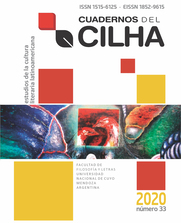The turns in La sangre de la aurora: The aesthetic of fragment and the remain
Keywords:
Aesthetic, Testimony, Body, Gender violence, HorrorAbstract
The border of what is recognizable and sensitive, and what it is not, are delimited in the dispute between the word and the scream; the sentence and the noise (Rancière, 2011). In the historic account it is configurated and organized what remains inside and outside. From the Final Report (2003), about Human rights violations perpetrated during the conflict within Shining Path and the Peruvian State Armed Forces (1980-2000), the Commission of Truth and Reconciliation bolded the use of sexual violence as a strategy of control. In this sense, the body of the women become a symbolic territory to delimit and reinforce social order (Segato, 2014). The present paper inquires how La sangre de la aurora (2013) by Claudia Salazar, essays different aesthetic turns to break the social frames that supports the official representation of history; and calls the catastrophe as a mean to configurate violence. Also, it articulates what has been acknowledged as noise. The paper explores, based on the concept remain (Agamben, 2006), the turns in contemporary literature when it uses different sources and research methodologies to approach the horror in contexts of violence. Among these remains are memory, archives, and testimonios.
References
Almenara, E. (2018). Trauma y memoria en La sangre de la aurora de Claudia Salazar y Magallanes de Salvador del Solar. Letras Femeninas. Número especial: Capitalismo, globalización y violencia de género, 43 (2), 55-67. https://firstmonday.org/ojs3/index.php/lf/article/view/9494
Agamben, G. (2006). "El archivo y el testimonio". En Homo Sacer III. Lo que queda de Auschwitz. Pre-Textos.
Boesten, J. (2016). Violencia sexual en la guerra y en la paz. Género, poder y justicia posconflicto en el Perú. Biblioteca Nacional del Perú.
Canal, S. (2016). La sangre de la aurora de Claudia Salazar. Las críticas. revista literaria hecha por mujeres. http://lascriticas.com/index.php/2016/10/31/la-sangre-la-aurora-claudia-salazar/
Castillejo, A. (enero, 2017). La globalización del testimonio. Historia, silencio endémico y los usos de la palabra. Antípoda. Revista de antropología y Arqueología, 4, 75-100. http://www.scielo.org.co/scielo.php?script=sci_arttext&pid=S1900-54072007000100005&lng=en&tlng=es
Fernandez Benitez, H. (2020). The moment of Testimonio is Over. Problemas teóricos y perspectivas de los estudios testimoniales. Ikala, Revista de Lenguaje y Cultura, 15 (24), 47-71. http://www.scielo.org.co/scielo.php?script=sci_arttext&pid=S0123-34322010000100003
Knupp, A. M. (2018). Lucanamarca, el genocidio y la violación sexual en La sangre de la aurora. Confluencia, 34(1), 83-93
Lozano Guzmán, L. (21 de agosto 2018). Novela, género y memoria. Diálogo con Claudia Salazar. https://www.youtube.com/watch?v=0Dw7D7jQu58&t=3566s
Mantilla Falcón, J. (2006). La comisión de la verdad y reconciliación en el Perú y la perspectiva de género: principales logros y hallazgos. Revista Instituto Interamericano de Derechos Humanos (IIDH), 43, 323-365. http://www.corteidh.or.cr/tablas/R08060-9.pdf
Molina Olivares, M. (2019). Género y memoria en La sangre de la aurora de Claudia Salazar. Revista de Estudios Transatlánticos, 22, 90-109. https://digibug.ugr.es/handle/10481/59056
Monge, E. (2013). No contar todo. Random House.
Paredes Morales, J. (2018). De cuerpos y ruinas. Análisis de la novela La sangre de la aurora. Red Literaria Peruana. https://redliterariaperuana.com/2018/06/16/de-cuerpos-y-ruinas-analisis-de-la-novela-la-sangre-de-la-aurora/
Parrini, R; González Marín, D; Luna, A. (2019). Un archivo de sombras. Una mirada etnográfica sobre una pieza de Teatro Línea de Sombra. Investigación Teatral. Revista de Artes Escénicas y Performatividad. Universidad Veracruzana, 10 (15), 6-26.
Rancière, J. (2011). Política de la literatura. Libros del Zorzal.
Richard, N. (2010). Crítica de la memoria. Ediciones Universidad Diego Portales.
Salazar, C. (2013). La sangre de la aurora. Animal de invierno.
Salazar, C. (2013). Género y violencia en la literatura peruana: Rosa Cuchillo y Las hijas del terror. Confluencia. Derechos Humanos y Literatura, 29(1), 69-80.
Saona, M. (2014). Imágenes de la ausencia. Revista Cronopio, 53. https://www.academia.edu/9679829/Imágenes_de_la_ausencia
Sarlo, B. (2012). Tiempo pasado/Cultura de la memoria y el giro subjetivo. Una discusión. Siglo XXI.
Sarti, C. Decir lo indecible. Desacatos, 62, 88-97. http://desacatos.ciesas.edu.mx/index.php/Desacatos/article/view/2201
Segato, R. (2014). Las nuevas formas de guerra y el cuerpo de las mujeres. Pez en el árbol.
Scott, J. (2001). Experiencia. La ventana, 13, 42-73. http://148.202.18.157/sitios/publicacionesite/pperiod/laventan/Ventana13/ventana13-2.pdf
Vivanco, L. (2018). Tres veces muertos: narrativas para la justicia y la reparación de la violencia simbólica en el Perú, Revista Chilena de Literatura, 97, 127-152.
Vich, V. (2015). Poéticas del duelo. Ensayos sobre arte y memoria y violencia en el Perú. IEP.












































